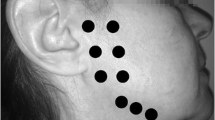Background:
Has a conscious exclusion of the contralateral major salivary glands (parotid, submandibular, and sublingual glands) a significant impact on the milieu of the oral cavity (saliva flow, pH, buffer capacity, and colonisation with Streptococcus mutans) in patients with ENT tumors receiving radical radiotherapy?
Patients and Methods: 20 consecutive consentient patients with ENT tumors were evaluated once before, weekly during, and 6 weeks after the end of treatment in regard to saliva flow, ph, buffer capacity, and colonisation with Streptococcus mutans. In 13 patients the major salivary glands on both sides were included in the treated volume, in seven patients the treatment portals excluded consciously the contralateral major salivary glands.
Results: The stimulated saliva flow decreases already during the 1st week of radiotherapy, the decrease follows the dose exponentially; the saliva flow is further reduced in the weeks after the end of treatment. The effect is less pronounced in patients with sparing of contralateral major salivary glands. The majority of patients with unilateral sparing of the major salivary glands retain the baseline value of buffer capacity, whereas buffer capacity of all patients with inclusion of all major salivary glands is markedly reduced with 20 Gy already, without signs of recovery when treatment has stopped. With unilateral salivary gland sparing the pH always remains basic, in bilaterally irradiated patients the pH changes from a mean of 7.3 to 5.8 during treatment. The colonisation with Streptococcus mutans varies little in both groups during the radiotherapy; after the end of therapy, it is higher in bilaterally irradiated patients.
Conclusions: The conscious arrangement of irradiation portals in order to spare contralateral major salivary glands in patients with radical radiotherapy of ENT tumors has a significant influence on the oral environment: the stimulated saliva flow is higher, the buffer capacity retains the baseline value, the saliva pH remains basic, and the colonisation with Streptococcus mutans is reduced.
Hintergrund:
Welchen Einfluss hat das bewusste Aussparen der kontralateralen großen Speicheldrüsen (Glandulae parotis, submandibulares und sublinguales) bei radikaler Strahlentherapie von HNO-Tumoren auf das Milieu der Mundhöhle (Speichel-pH, -Pufferkapazität, -flussrate und Streptococcus-mutans-Kolonisation)?
Patienten und Methoden: 20 konsekutive, zustimmende Patienten mit HNO-Tumoren wurden einmal vor, wöchentlich während und 6 Wochen nach Abschluss der Radiotherapie bezüglich Speichelflussrate, pH-Wert, Pufferkapazität des Speichels sowie Kolonisierung mit Streptococus mutans untersucht. Bei 13 Patienten waren alle großen Speicheldrüsen im behandelten Volumen eingeschlossen, bei sieben Patienten sparte die Feldanordnung bewusst die kontralateralen Speicheldrüsen aus.
Ergebnisse: Die stimulierbare Speichelmenge nimmt schon während der 1. Woche der Radiotherapie ab, sinkt exponentiell zur Dosis und reduziert sich in den Wochen nach Abschluss der Therapie weiter. Der Effekt ist bei Patienten mit Schonung der kontralateralen großen Speicheldrüsen deutlich geringer ausgeprägt. Die Mehrzahl der Patienten mit einseitiger Schonung hält den Ausgangswert der Pufferkapazität, während alle Patienten mit Einschluss aller großen Speicheldrüsen schon bei Dosen ab 20 Gy erheblich an Pufferkapazität in der Mundhöhle ohne Zeichen der Erholung nach Abschluss der Therapie verlieren. Bei einseitiger Schonung bleibt der Speichel-pH immer basisch; bei beidseitig bestrahlten Patienten sinkt der pH während und nach der Radiotherapie von 7,3 Mittelwert auf 5,8 ab. Die Kolonisierung mit Streptococcus mutans variiert in beiden Patientengruppen während der Radiotherapie wenig; sie ist bei beidseitig bestrahlten Patienten nach Abschluss der Therapie höher als bei Patienten mit Schonung einer Parotis.
Schlussfolgerungen: Die bewusste Anordnung der Felder zur Schonung der kontralateralen großen Speicheldrüsen bei Radiotherapie von HNO-Tumoren hat einen signifikanten Effekt auf das Milieu der Mundhöhle: Die stimulierbare Speichelmenge bleibt größer, die Pufferkapazität hält den Ausgangswert, der Speichel-pH bleibt basisch und die Kolonisierung mit Streptococcus mutans bleibt auf dem Niveau des Behandlungsbeginnes.
Similar content being viewed by others
Author information
Authors and Affiliations
Additional information
Received: October 24, 2001; accepted: August 2, 2002
Correspondence Address Richard H. Greiner, MD, Department of Radiation Oncology, University Bern, Inselspital, Freiburgstrasse 10, 3010 Bern, Switzerland, Phone (+41/31) 632-2410, e-mail: richard.greiner@insel.ch
Rights and permissions
About this article
Cite this article
Beer, K., Zehnder, D., Lussi, A. et al. Sparing of Contralateral Major Salivary Glands Has a Significant Effect on Oral Health in Patients Treated with Radical Radiotherapy of Head and Neck Tumors. Strahlenther Onkol 178, 722–726 (2002). https://doi.org/10.1007/s00066-002-0961-4
Issue Date:
DOI: https://doi.org/10.1007/s00066-002-0961-4




